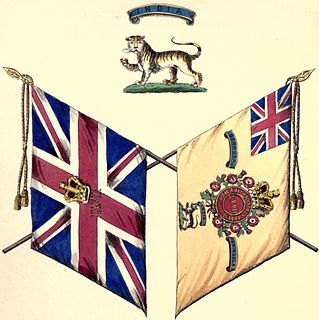Related Research Articles
The 77th Regiment of Foot was a Highland Scots Regiment raised in 1757. The 77th Regiment was one of the first three Highland Regiments to fight in North America. During the Seven Years' War, the regiment lost 110 soldiers and 259 were wounded.
The 78th Regiment, (Highland) Regiment of Foot also known as the 78th Fraser Highlanders was a British infantry regiment of the line raised in Scotland in 1757, to fight in the Seven Years' War. The 78th Regiment was one of the first three Highland Regiments to fight in North America.

The 42nd Regiment of Foot was a Scottish infantry regiment in the British Army also known as the Black Watch. Originally titled Crawford's Highlanders or the Highland Regiment and numbered 43rd in the line, in 1748, on the disbanding of Oglethorpe's Regiment of Foot, they were renumbered 42nd and in 1751 formally titled the 42nd (Highland) Regiment of Foot. The 42nd Regiment was one of the first three Highland Regiments to fight in North America. In 1881 the regiment was named The Royal Highland Regiment , being officially redesignated The Black Watch in 1931. In 2006 the Black Watch became part of the Royal Regiment of Scotland.

The 67th Regiment of Foot was a line infantry regiment of the British Army, raised in 1756. Under the Childers Reforms it amalgamated with the 37th Regiment of Foot to form the Hampshire Regiment in 1881.
The 100th Regiment of Foot, also known as Campbell's Highlanders, was an infantry regiment of the British Army, formed in 1760 and disbanded in 1763.
The 88th Regiment of Foot , or Campbell's Highlanders, was a Scottish infantry regiment in the British Army, formed in 1760 and disbanded in 1763.
The 87th Regiment of Foot was a Scottish infantry regiment in the British Army, formed in 1759 and disbanded in 1763.
The 115th Regiment of Foot was an infantry regiment of the British Army from 1761 to 1763.
The 101st Regiment of Foot, or Johnston's Highlanders, was an infantry regiment of the British Army, formed in 1760 and disbanded in 1763. The regiment was raised in 1760 by the regimentation of independent companies of infantry raised in Argyll and Ross-shire; in 1761 it was moved into England, and its other ranks drafted to the 87th and 88th Foot.
The 113th Regiment of Foot, known as the Royal Highlanders, was authorized on 17 October 1761, and raised in Great Britain for service of the British Army under the command of James Inglis Hamilton. The regiment served as a depot for sending drafts to Highland regiments serving overseas. It was disbanded in 1763.
The 112th Regiment of Foot was an infantry regiment of the British Army from 1761 to 1763. It was raised in October 1761, taking its name from George III, and was disbanded in 1763.
The 110th Regiment of Foot was an infantry regiment of the British Army from 1761 to 1763.
The 109th Regiment of Foot was an infantry regiment of the British Army from 1761 to 1763.
The 108th Regiment of Foot was an infantry regiment of the British Army from 1761 to 1763. It was raised in October 1761 from a cadre of the 31st Regiment of Foot, and was disbanded in 1763.
The 107th Regiment of Foot was an infantry regiment of the British Army from 1761 to 1763. It was raised in October 1761 by regimentation of independent companies, and was disbanded in 1763.
The 106th Regiment of Foot was an infantry regiment of the British Army that existed from 1761 to 1763. While the regiment operated during the Seven Year's War, it was deployed only in the British Isles, specifically in the southwest of England.
The 104th Regiment of Foot was a short-lived infantry regiment of the British Army active during the Seven Years' War.
The 103rd Regiment of Foot was a British Army regiment formed at Bury St Edmunds in October 1760. It took part, alongside the Royal Marines, in the Capture of Belle Île in April 1761 during the Seven Years' War. It was then disbanded in England in 1763.
The 90th Regiment of Foot was a short-lived infantry regiment in the British Army which was raised in Ireland as a light infantry corps in 1759, during the Seven Years' War with France.
References
- ↑ "114th Regiment of Foot (Royal Highlander Volunteers)". scotWars.com. Archived from the original on 13 January 2010.
- ↑ "114th Regiment of Foot". regiments.org. Archived from the original on 16 October 2007.